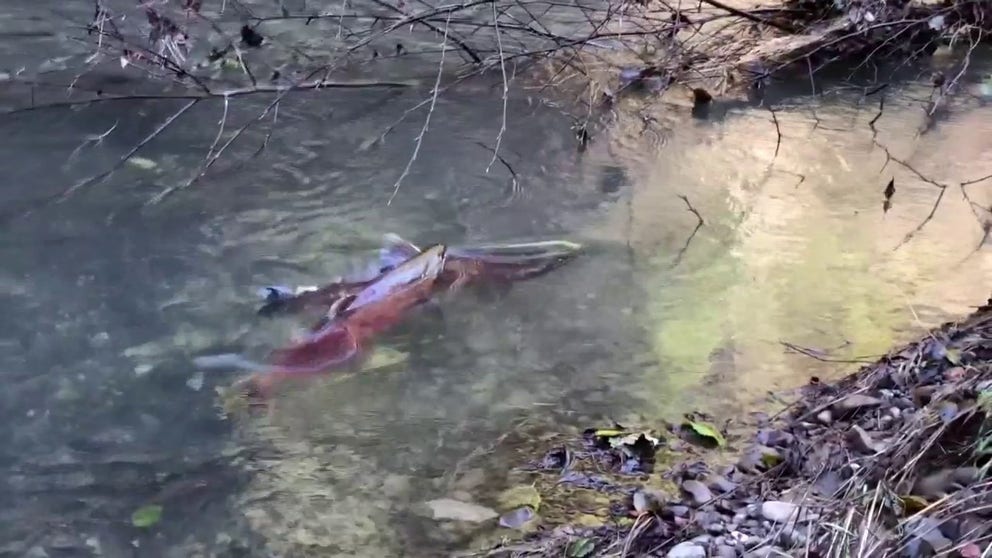Endangered coho salmon: California's comeback kid with 'surprisingly strong' spawning season, says NPS
So far the 2023/24 spawning season is the most promising in over 15 years for the Central California coho salmon.
Watch: Coho salmon fighting in Northern California
National Park Service Fishery Biologist Michael Reichmuth found a few male coho salmon fighting in Olema Creek in the Point Reyes National Seashore, north of San Francisco.
POINT REYES NATIONAL SEASHORE, Calif. – California's coho salmon have made a surprising comeback. The 2023-24 spawning season is on track to be the best in more than 15 years, said the National Park Service in a statement.
"On one of the creeks, Olema Creek, the one that we saw the most spawning on, we thought we'd see somewhere in the neighborhood of around 40 nests," National Park Service Fishery Biologist Michael Reichmuth said. "And we're looking at double that. So, that's a pretty big surprise and encouraging to see those kinds of numbers because it means the fish had high survival through their life, getting to that point."
"We had an epic day on Olema, with a single-day count of 150 adult coho salmon. This is the highest single-day count that we have (ever) recorded," he said.
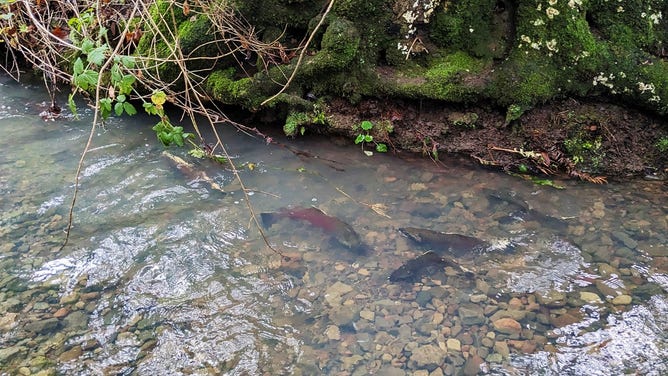
Looking down along the bank of a creek are at least four large, olive- and crimson-colored coho salmon making their way upstream. Several adult coho swim up the John West Fork of Olema Creek on January 2nd. This season is on track to be the best spawning season on Olema Creek in more than 15 years.
(NPS / FOX Weather)
He forecasts the number of nests, or redds, based on the number of fish he sees leaving the creek a year and a half prior. Coho typically hatch and grow in a creek or river for a year and a half. They spend another year and a half in the open ocean as adults eating and building up energy reserves for the arduous swim back upstream to lay eggs. The salmon have a three-year life cycle.
The survey team counted about 70 nests in Olema which is five times more than the number three years ago.
Grim 2022/23 spawning season
The survey team saw only two nests last winter in Olema Creek. In nearby Redwood Creek, running through Muir Woods National Monument, the team couldn't find a single live coho and only one nest. Reichmuth raised an alarm to the California Department of Fish and Wildlife, which was able to release 4,000 juvenile coho in the creek. That batch won't return until 2025.
HOW SALMON NUMBERS RISE AND FALL DURING EL NINO AND LA NINA
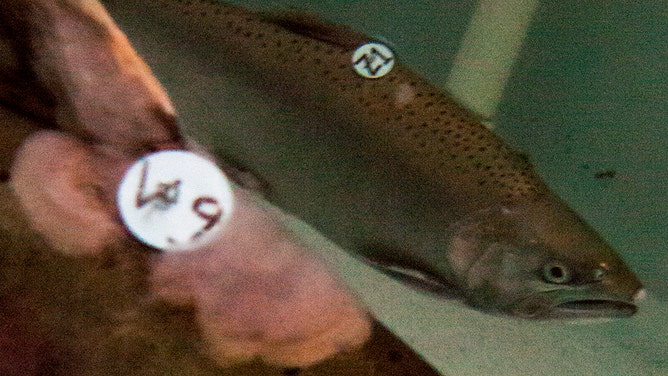
File: Coho salmon tagged and awaiting release, are kept in holding tanks at a conservation hatchery.
( Robert Gauthier/Los Angeles Times / Getty Images)
"Last year, that group of fish, in contrast to what we saw with that group that came back to spawn this year, it was just poor survival along the way," he said. "And we also had severe drought when those fish were babies."
Large portions of the creek dried up, leaving fewer areas for fish to go. Shallow water also heats up faster, and the coho needs cool water. The state goes through years of extreme drought punctuated by drought-busting years of atmospheric river storms, like we have seen the past two winters. Drought prevailed in the three previous years.
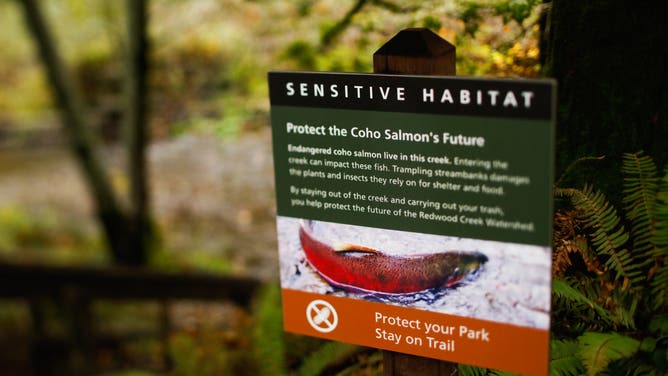
File: A sign to protect the Coho Salmon is seen at Muir Woods in Mill Valley, California.
(Gabrielle Lurie/San Francisco Chronicle / Getty Images)
More hope for the 2024/25 spawning season
Despite next winter being the last generation of coho that was born in drought, Reichmuth is hopeful for another good spawning year.
HOW TOO MUCH AND NOT ENOUGH RAINFALL IS HURTING FISH IN THE WEST
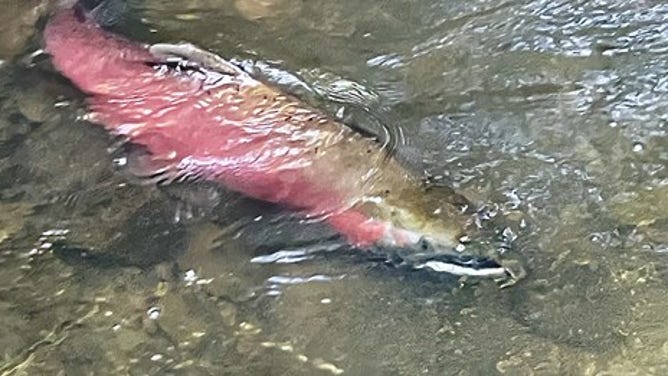
A coho salmon swimming upstream.
(NPS / FOX Weather)
"That drought year (2022) luckily wasn't as bad as the year before. So I'm hoping that (fish) they're doing better," he said. "We think it'll be a pretty good run, because we actually did have a good run of fish that year. And we had a lot of smolts leave our creeks, so. And they looked pretty healthy leaving."
He said he wants to see the numbers of returning salmon from this year, every year in Olema Creek, to call it a recovery. Redwood Creek, with 22 live adults this winter, is falling well behind his hopes of 100 every year.
Population in decline
He said that the coho population has been declining over the past 20 years he has been surveying, with a couple of good years like this one. The state has been working to restore fish habitat. Crews add more overhanging trees to shade and keep the water cool. They will reroute the creek and add logs and rocks to give the coho areas to hide from predators and swift currents.
"One of the things we want to do is try to grow fish so they're leaving as large as they can and increase the number leaving. And it's looking like the fish are getting bigger before they migrate out by providing better habitat for them. And so hopefully, that translates into, as we move forward, higher survival in the ocean," Reichmuth said.
Central California coast coho added to the Endangered Species Act in 1996
SALMON FACE ALTERED EXISTENCE FROM CLIMATE CHANGE, SCIENTISTS SAY
NOAA Fisheries considers the Central California coho salmon among the most endangered. The population was declared endangered in 1996.
"Historically, coho salmon were abundant on the north central California coast, supporting native, recreational and commercial fishing, but this species has declined primarily from habitat loss," states NOAA.
Logging and agriculture have deforested banks, decreased water flow and straightened rivers taking away habitat.
Restoring habitat and getting the salmon back to a sustainable population is important, both NOAA and Reichmuth said.
CAUTION: SALMON CROSSING! SEASON'S FIRST FLOOD BRINGS ANNUAL MIGRATION TO STREETS NEAR SEATTLE
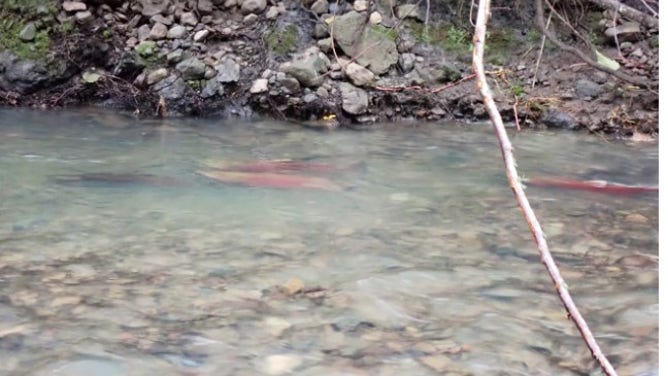
Coho salmon returning to Olema Creek to spawn in November 2021.
(NPS / FOX Weather)
"We call it an indicator species because, since they use the whole watershed, it's a good way of telling you if your watershed is healthy or not," Reichsmuth said. "So, we think if we can get them coming back on a regular basis, it means that all the processes are working correctly there and that we're improving the health of the watershed, which means all the other aquatic species or other species that rely on that, the system is probably most likely also doing better."
Salmon generally return to the rivers where they were hatched.
